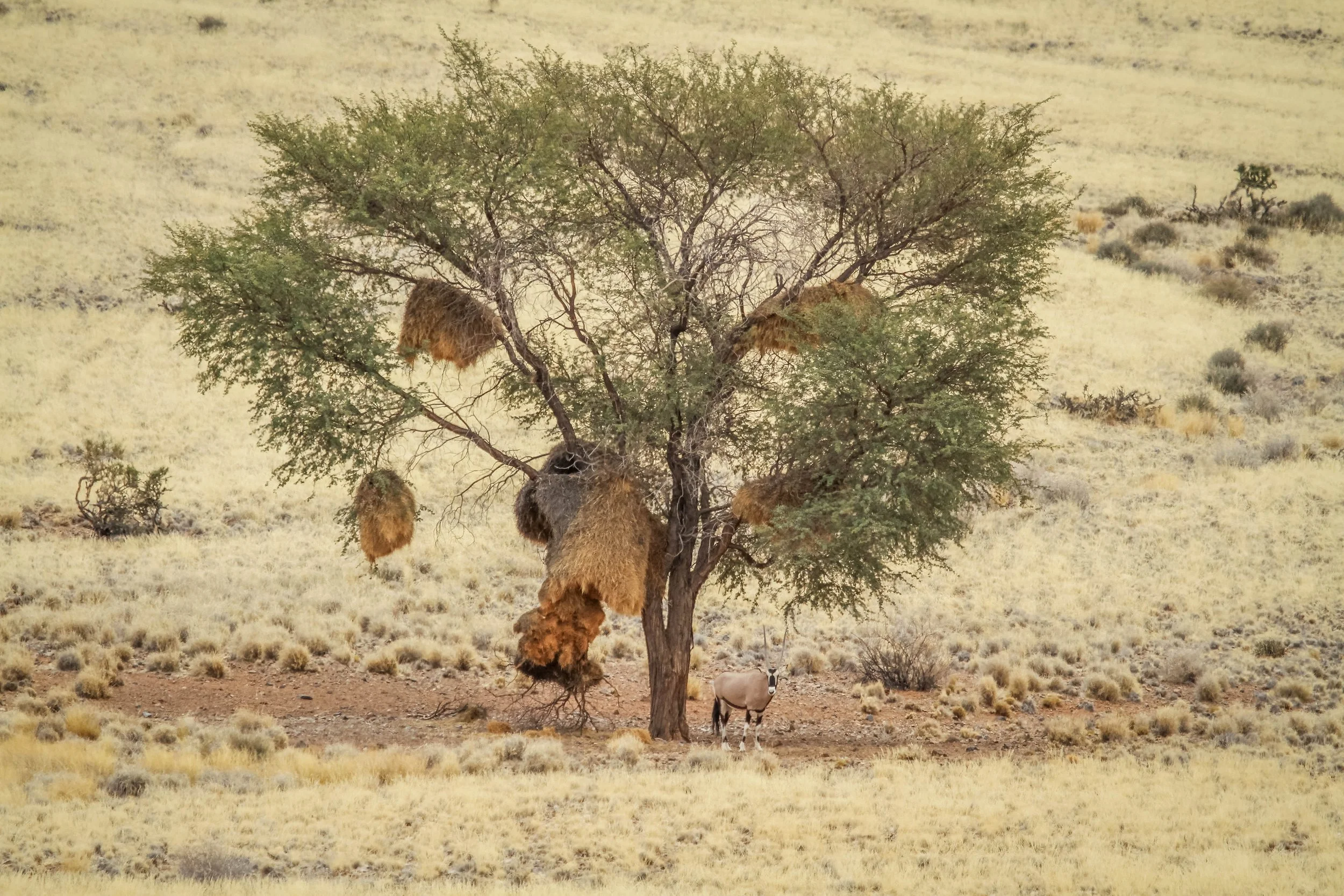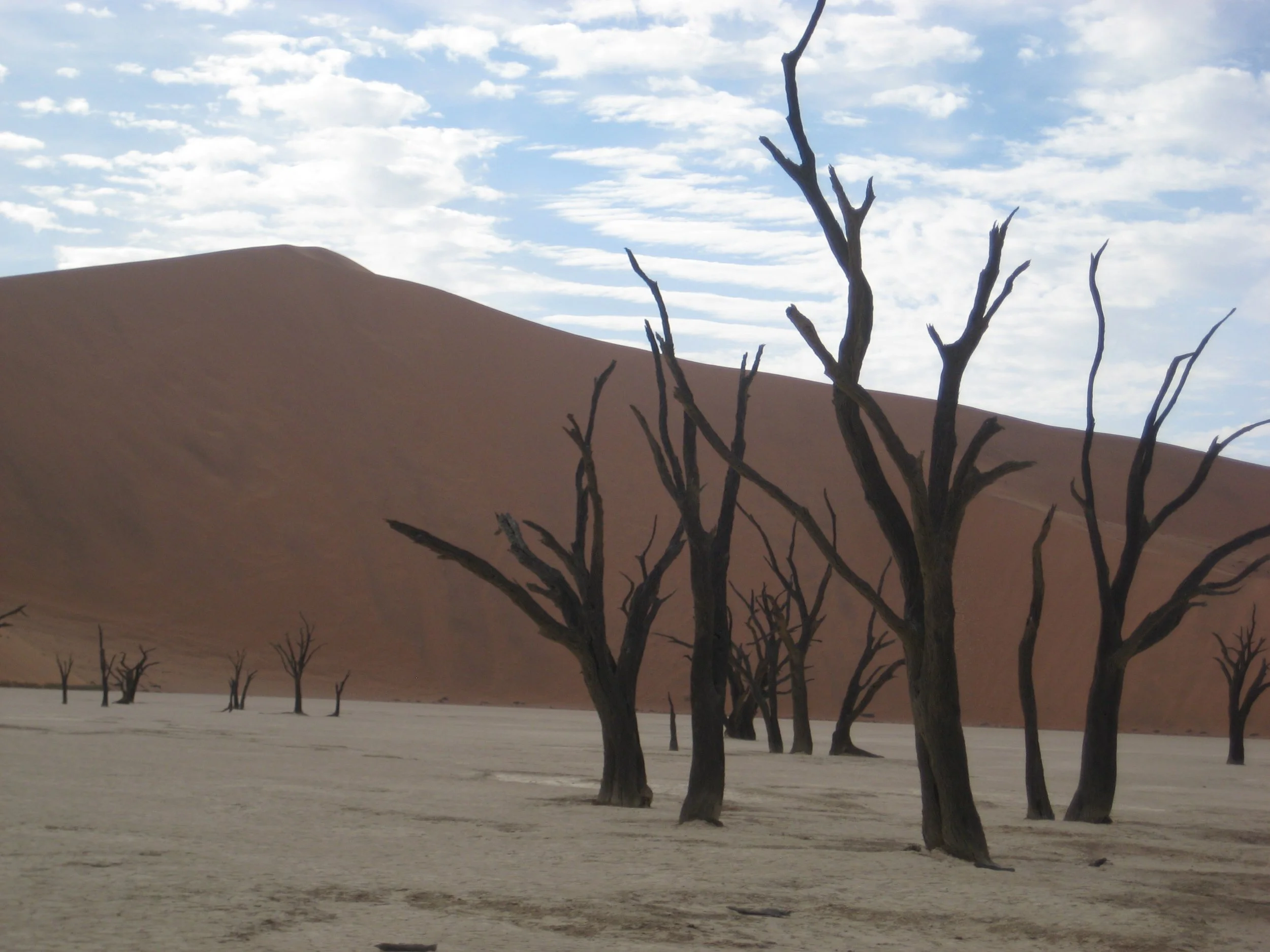
Namibia - experience the world's largest and oldest deserts, soaring dunes and deep canyons, high rock massifs - under the sunniest skies and starriest nights.
Where to go in Namibia - rocks & sand, mountains & valleys, canyons & plains
-

Sossusvlei
A vast dry sea of giant red sand dunes lies along the coast of the Southern Namib-Naukluft National Park, ‘rolling’ between the icy cold waters of the Atlantic Ocean and the hot blue/grey mountains of the interior. Despite the harsh desert conditions in the area, one can find a wide variety of plants and animals that have adapted to survive.
Climb the dunes, photograph eerie Dead Vlei, wonder about the ‘fairy circles’, learn about the Oryx and Buffalo Weaver nests, fly serenely over it all in a hot air balloon.
-

Etosha
The seemingly endless, shimmering, flat white salt pans of Etosha National Park are the dry remnants of an ancient, inland sea. Called ’the great white place’ in Ovambo, they support a remarkable diversity of animals, which congregate around welcome waterholes, and so are easily visible.
Sit quietly at a waterhole - some floodlit at night - and drive slowly along the roads, looking out for wildlife, including both the endangered Black and White Rhino.
-

Damaraland
Sandy, tree-lined river valleys, frequented by desert elephants, are set against a beautiful backdrop of endless mountain vistas in greys, mauves & purples, on soft terracotta soils, under brilliant blue skies. The stark river beds are dry - precious moisture is provided by early morning fogs rolling in from the distant sea. Ancient Bushman art is etched into red rocks. Beautiful Himba still wear their traditional clothing.
Drive along ancient dry river beds, looking for the rare desert-adapted Elephant. Marvel at the curious, bottled-shaped Pachypodiums, candelabra-like Spiny Euphorbias, and ancient, leathery Welwitshias. These weird and wonderful plants have an underground trunk, and only two leaves that grow continuously, and can live for 1 000 years or more. Also hike the hills, and meet the Himba.
-

Spiztkoppen
The magical Spitzkoppe and Pondok (grass hut) mountain ranges provide breathtaking views into the Namib desert and burning red sunsets. They are the premier rock climbing destination in Namibia. In the rains, pools form in the granite depressions supporting rare aquatic creatures, including endemic frogs, and plants and supply water to other wildlife. The rivers only run for a few days each year but nevertheless hold moisture below the surface allowing for more abundant vegetation than out on the sizzling plains. There 42 species of lizard, 19 of which are endemic to the area. The birding is excellent, particularly for raptors.
Take a walk and photograph to your heart’s content. Observe the little creatures.
-

Windhoek
Windhoek, the capital of Namibia, sits on the Khomas Highland plateau, almost exactly at the country's geographical centre. At 1,700 metres above sea level, surrounded by rocky, mountainous areas, its 430 000 inhabitants enjoy 300 days of sunshine a year. It was initially founded, in 1840, by Jonker AfrikanIter, leader of the Oorlam Clan. After neglect and destruction, it was rebuilt in 1890, by Major Curt von Francis of the Imperial German Empire. Today the city is the social, economic, political, and cultural centre of the country., and the main gateway to the tourist areas.
Take a tour of Windhoek, visiting the Houses of Parliament and Gardens, the Namibia Craft Center, Christ Church, and the Old Fort. From the city center, head to the Katutura Township to catch a glimpse of daily life in Windhoek's largest suburb.
-

Erongo
The granitic Erongo Mountains (2370m), are remnants of ancient volcanoes, where desert, mountain and Bushveld ecosystems combine in a very special wilderness area. There are several interesting ancient caves and rock painting sites to visit.
Capturing great images of the the rocks at dusk, and the delicate paintings in the caves, are the dream of photographers - amateur and professional alike.
-

Waterberg
The Waterberg Plateau, is a huge red, flat topped mountain rising from the plains of the Kalahari Desert. Permanent streams give rise to the name ‘water mountain’. Lush forests and sheltered valleys provide sanctuary for animals such as buffalo, rhino, eland, roan and sable. Also a wide variety of plant species - some endemic to the Waterberg. Baboon, klipspringer, kudu and leopard live among the rocks. On the plains, giraffe, oryx, hartebeest, impala, wildebeest, zebra and springbok roam. Cheetah, hyena & jackals are also seen. Birdlife is abundant, with specials, such as Ruppel’s Parrot, to excite the twitchers.
Hiking, game drives and learning about the history of the area, such as the battle between the Herero people and the German colonial forces beween 1904 and 1907, are popular activities.
What you can experience in Namibia









